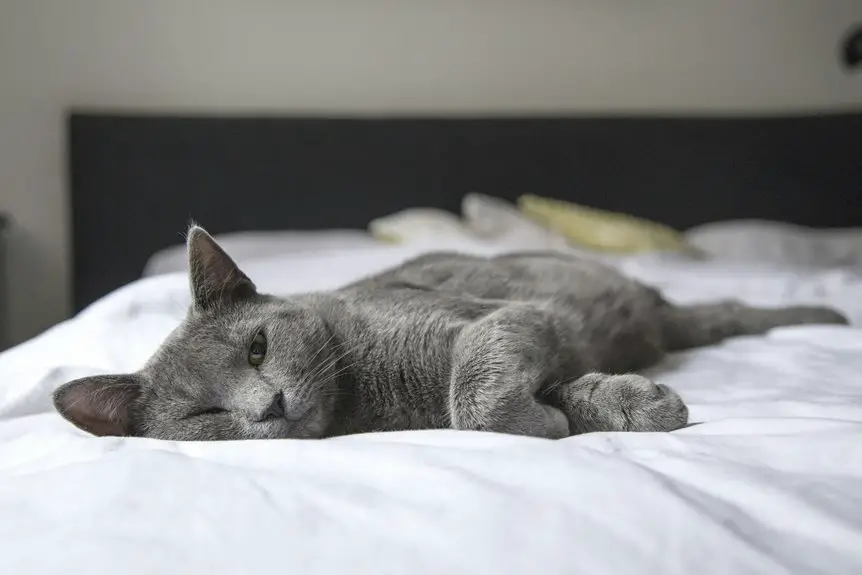Yes, cats do scratch corduroy because its soft, ridged texture feels great under their claws and helps them mark territory and stretch. To protect your furniture, provide sisal or carpet scratching posts as alternatives, trim your cat’s nails regularly, and use pet-safe deterrents or covers on vulnerable spots. Training your cat to use their posts with treats and praise also helps. Keep going for easy ways to shield and maintain your corduroy pieces from damage.
Table of Contents
Key Takeaways
- Cats naturally scratch corduroy due to its soft texture and ridged surface, which satisfy their claw maintenance and marking instincts.
- Scratching on corduroy often causes visible fraying, worn patches, and flattened ribs, signaling fabric damage.
- Provide sisal or carpet scratching posts to redirect cats from furniture and encourage healthy scratching behavior with treats and praise.
- Use slipcovers, double-sided tape, or pet-safe deterrent sprays on corduroy furniture to protect vulnerable areas from scratches.
- Regularly trim your cat’s nails and maintain corduroy fabric by brushing and timely cleaning to minimize and repair damage.
Understanding Why Cats Scratch
Although it might seem frustrating, your cat scratches because it’s a natural and essential behavior. You should understand that scratching helps cats mark territory, stretch muscles, and shed old claw sheaths.
Scratching is a natural behavior that helps cats mark territory, stretch muscles, and shed old claw sheaths.
It’s their way of communicating and keeping their claws healthy. When you see your cat digging into your furniture, it’s not about being destructive; it’s fulfilling a basic need.
If you want to protect your fabric furniture, recognizing this instinct is the first step. Instead of punishing your cat, consider providing alternatives like scratching posts or pads.
These give your cat an acceptable outlet for this behavior, reducing the chances they’ll target your couch or chairs. Remember, scratching is part of your cat’s nature—you just have to guide it appropriately.
What Makes Corduroy Appealing to Cats
You’ll notice cats are drawn to corduroy because its unique texture feels satisfying under their claws.
It offers an ideal surface for scratching, helping them keep their claws sharp and healthy.
Plus, corduroy easily holds their scent, making it a perfect spot for marking territory.
Texture and Feel
Three key features make corduroy especially appealing to cats: its soft texture, distinct ridges, and slight warmth. When your cat encounters corduroy, it’s drawn to these sensory qualities that feel satisfying under their paws.
- Soft Texture: The plush feel of corduroy mimics natural surfaces cats enjoy, encouraging them to knead or scratch.
- Distinct Ridges: The raised ridges provide a tactile experience that cats instinctively like to dig their claws into.
- Slight Warmth: Corduroy tends to retain warmth, making it a cozy spot where your cat feels comfortable lounging or scratching.
Understanding these features helps you anticipate why your cat might target corduroy, allowing you to protect your fabric furniture more effectively.
Claw Maintenance Surface
Beyond its texture and warmth, corduroy also serves as an ideal surface for your cat to maintain their claws. The fabric’s ridged pattern provides your cat with a satisfying resistance when they scratch, helping to naturally shed the outer layers of their claws.
This action keeps their claws sharp and healthy, which is essential for their comfort and mobility. Unlike smooth surfaces, corduroy offers the right amount of grip, making it easier for your cat to dig in with their claws.
When you notice your cat scratching your corduroy furniture, it’s not just random behavior—it’s a necessary grooming habit. Understanding this can help you find better ways to redirect scratching without compromising your furniture’s condition.
Scent Marking Appeal
Although corduroy’s texture invites scratching, its appeal to cats goes deeper—literally into their sense of smell.
Cats use scent marking to claim territory, and certain fabrics like corduroy can retain their unique scents better than smooth materials. When you notice your cat scratching corduroy, it’s often about leaving their signature behind.
Here’s why corduroy appeals to their scent-marking instincts:
- Fabric grooves: The ridges trap and hold scent glands’ secretions longer, making their mark last.
- Absorbent fibers: Corduroy absorbs oils from your cat’s paws, enhancing scent retention.
- Familiar environment: The scent-marked fabric reassures your cat, reinforcing comfort and ownership.
Understanding this helps you protect your furniture while respecting your cat’s natural behavior.
Common Signs of Cat Scratching on Corduroy
You’ll notice visible fabric damage when your cat scratches corduroy, like worn patches or frayed edges.
Loose threads or fibers often hang from the fabric, making it look tattered.
Recognizing these signs early helps you protect your furniture before the damage worsens.
Visible Fabric Damage
When cats scratch corduroy fabric, you’ll notice distinct signs of damage that can quickly ruin your furniture’s appearance.
Recognizing these signs early helps you take action before the damage worsens.
- Faded or Discolored Patches: Scratching wears down the fabric’s nap, leaving dull, uneven areas that stand out against the rest of the material.
- Indentations or Flattened Ridges: The raised ribs of corduroy get crushed or flattened where claws repeatedly strike, disrupting the fabric’s texture.
- Small Surface Tears: You might spot tiny rips or snags in the fabric where the claws have punctured, signaling that further tearing could follow if unchecked.
Spotting these visible signs lets you protect your furniture and keep it looking fresh longer.
Loose Threads or Fibers
Visible fabric damage like faded patches and small tears often comes with another common sign of cat scratching on corduroy furniture: loose threads or fibers.
When your cat digs its claws into the fabric, the tightly woven ridges can start to unravel, leaving strands hanging loose. You’ll notice these threads catching on your fingers or your cat’s claws, making the damage worse over time.
If you spot loose fibers, it’s a clear sign your cat has been scratching there repeatedly. To prevent further unraveling, trim the loose threads carefully instead of pulling them.
Covering the area with a slipcover or protective fabric can also help. Addressing loose threads early keeps your corduroy looking neat and avoids bigger repairs later.
Effective Scratching Alternatives for Cats
Although cats naturally want to scratch, providing effective alternatives can protect your fabric furniture from damage. You can redirect their energy and keep your corduroy pieces safe by offering satisfying scratching options.
Cats’ natural scratching instincts can be redirected with the right alternatives to protect your corduroy furniture.
Here are three great alternatives:
- Scratching Posts: Choose tall, sturdy posts wrapped in sisal or carpet to mimic your furniture’s texture. Place them near favorite lounging spots.
- Scratching Pads: Flat or angled pads made of cardboard or woven materials give cats a variety of surfaces to scratch.
- Interactive Toys: Toys with feathers or strings encourage playful scratching and divert attention from furniture.
How to Protect Corduroy Furniture From Damage
Protecting your corduroy furniture from cat damage requires a mix of prevention and care.
First, cover vulnerable spots with slipcovers or washable throws to shield the fabric from claws. You can also use double-sided tape or a pet-safe deterrent spray on areas your cat targets; cats dislike sticky surfaces and certain scents, which helps keep them away.
Regularly trim your cat’s nails to reduce the impact of scratching. Place scratching posts nearby to redirect their behavior.
Clean any fabric stains promptly with mild soap and water to prevent permanent damage. Finally, rotate cushions and vacuum your furniture often to maintain its texture and appearance.
Taking these steps keeps your corduroy looking fresh while accommodating your cat’s natural instincts.
Training Your Cat to Avoid Scratching Furniture
Since cats naturally scratch to mark territory and sharpen their claws, training them to avoid your furniture takes patience and consistency.
You can guide your cat’s behavior by providing appealing alternatives and reinforcing positive habits.
- Place scratching posts in areas your cat frequents. Choose sturdy posts covered with materials cats like, such as sisal.
- Reward your cat with treats and praise whenever they use the scratching post instead of your furniture.
- Redirect unwanted scratching immediately by gently moving your cat to the post and encouraging its use.
Using Cat Deterrents Safely on Corduroy
When you use cat deterrents on corduroy, you need to be careful to avoid damaging the fabric.
Avoid sprays that contain harsh chemicals or oils, as they can stain or weaken the material. Instead, opt for gentle, pet-safe sprays designed specifically for fabric protection.
Test any product on a hidden area first to verify it won’t discolor or harm the corduroy.
Sticky tapes or mats can deter scratching, but place them carefully to prevent residue or fabric pulling.
Ultrasonic deterrents work well without touching the furniture, providing a safe alternative.
Always monitor your cat’s reaction and adjust methods as needed.
Using these deterrents thoughtfully helps protect your corduroy furniture while keeping your cat safe and comfortable.
Maintaining Corduroy Furniture After Scratches
Even with careful use of deterrents, scratches on your corduroy furniture can still happen. When they do, quick maintenance is key to keep your pieces looking great. Here’s how you can handle scratches effectively:
- Assess the Damage: Check if the fabric is just surface-scratched or if fibers are pulled. This helps you decide your next step.
- Gently Brush the Fabric: Use a soft brush to realign the corduroy ribs. Brushing in the fabric’s natural direction will reduce the appearance of scratches.
- Use Fabric Repair Products: For deeper scratches, apply a fabric-safe adhesive or patch designed for upholstery. Follow instructions carefully to blend repairs seamlessly.
Frequently Asked Questions
Can Scratching Corduroy Cause Health Issues for My Cat?
Scratching corduroy itself won’t cause health issues for your cat, but sharp fabric edges might irritate their paws. Keep their nails trimmed and provide scratching posts to protect both your cat’s health and your furniture.
Are Certain Cat Breeds More Likely to Scratch Corduroy Furniture?
You’ll find that some cat breeds, like Bengals or Siamese, tend to scratch more due to their high energy. But scratching habits depend more on individual personality than breed alone, so watch your cat closely.
Does the Color of Corduroy Affect How Visible Scratches Are?
You might not know, but 70% of pet owners say scratches show more on lighter fabrics. So, with corduroy, darker colors hide scratches better, helping you keep your furniture looking fresh longer.
Can Fabric Protectors Damage the Texture of Corduroy?
You might worry fabric protectors will harm corduroy’s texture, but most sprays are designed to be gentle. Just test on a small area first to avoid damage, ensuring your fabric stays soft and protected.
Is It Safe to Use Essential Oils as Cat Deterrents on Furniture?
You shouldn’t use essential oils as cat deterrents on furniture since many oils can be toxic to cats. Instead, try safe alternatives like citrus scents or commercial pet repellents designed specifically for cats.
- What Is Needle-Punched Nonwoven Fabric? (E.G., Felt) - July 11, 2025
- Understanding Thermal Bonding in Nonwoven Fabric Manufacturing - July 11, 2025
- Can Nonwoven Fabric Be Used for Upholstery? - July 11, 2025






